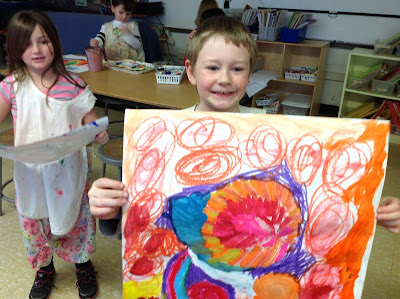Spirals are everywhere; from the tiniest organisms to the largest galaxies. 1st Grade students at UMS created these vibrant paintings after viewing a series of images of spirals seen throughout nature (including snails, hurricanes and fiddle-head ferns). On day one of this lesson, students drew a spiral and used it's shape to guide the direction and movement of their paintings. On the second day, students finished painting and embellished their spirals with colored oil pastels. These 1st grade artists have demonstrated immense creativity, color sensitivity, and expression through movement.
Monday, December 21, 2015
Friday, November 13, 2015
Drawing with Toys
Monday, November 9, 2015
Using our Imaginations to See
Tuesday, November 3, 2015
Why is Drawing Important?
Thursday, October 15, 2015
Autumn Floor Drawings
Today, students began drawing from life. This is a term that means drawing by looking at objects; closely observing the shape, texture, line and value of objects while trying to copy them through drawing.
We used items collected from natural areas as subject matter (twigs, rocks, shells, roots, flowers, leaves, etc.). Students selected one natural object at a time from the various trays of displayed materials. Then they placed their object on a large sheet of paper and tried to draw their object the way they saw it. It's much harder to do than it sounds, but these kids rocked the challenge and had a blast doing it. We used charcoal, pencils and pens for these drawings.
At one point, one of our second graders tried to borrow a shell from another students' paper until she realized it wasn't a shell...it was a drawing of a shell. Can't get more accurate than that!
We used items collected from natural areas as subject matter (twigs, rocks, shells, roots, flowers, leaves, etc.). Students selected one natural object at a time from the various trays of displayed materials. Then they placed their object on a large sheet of paper and tried to draw their object the way they saw it. It's much harder to do than it sounds, but these kids rocked the challenge and had a blast doing it. We used charcoal, pencils and pens for these drawings.
At one point, one of our second graders tried to borrow a shell from another students' paper until she realized it wasn't a shell...it was a drawing of a shell. Can't get more accurate than that!
Wednesday, September 23, 2015
Community Helpers
1st graders began to apply some new drawing techniques today through studying images of the vehicles that help our community. We began with a warm up to practice noticing different types of shapes and lines. Following that, we observed photographs and graphic pictures to help guide our drawings. We focused on police cars, ambulances, rescue helicopters, and fire engines. Kids can draw very accurately when they've got good instruction and support!
Thursday, September 3, 2015
Mr. Antonicci, artiste extraordinaire
We had a surprise visitor join Ms. Hughes's art class this afternoon. Mr. Antonicci jokes sometimes that he isn't a good artist, but I beg to differ! His self-portrait is pretty accurate, don't you think?
 |
| At UMS, everyone is an artist! |
 |
| Next week we'll add a watercolor background and explore how our color choices might suggest a mood for our self-portraits. Get ready to paint! |
Thursday, July 30, 2015
Summer Art
I hope everyone is having an exciting and creative summer. I know I have! Summer is a great time to recharge artistically for me. Here are some pictures of some of the paintings I've been working on for the past few weeks. These are all acrylics on canvas. Ask me in August about Acrylics and I'd be happy to share more information about their qualities and capabilities
.
 |
| At the Intersection of Battery St. and Maple St. |
 |
| Poker Hill Landscape |
 |
| Red Mountains |
 |
| Route 15, Jericho, VT |
Wednesday, May 20, 2015
Gyotaku: Japanese Fish Printing
This week at UMS we are continuing our studies in printmaking by learning about the traditional Japanese artform known as Gyotaku (meaning "fish print"). Gyotaku began in the mid-1800s as a way for fishermen to record their catch. Before selling their fish at the market, they'd make a print of the fish using ink and rice paper. Here's a video of contemporary artist, Naoki, discussing his Gyotaku process:
Here are some photos of Mrs. Davis' class trying it out for themselves. We used rubber fish!
Subscribe to:
Comments (Atom)













































